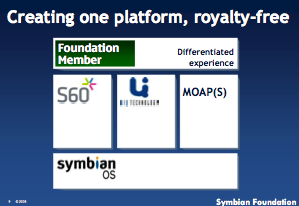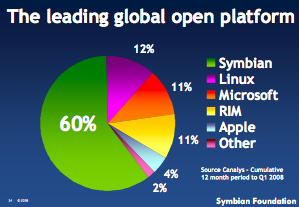 The boldest moves are made from a position of strength, not when the chips are down and you’ve very little to lose. Nokia’s decision, announced today, to acquire the remaining 52 per cent of Symbian it doesn’t already own and make the mobile platform open source, is bold to say the least.
The boldest moves are made from a position of strength, not when the chips are down and you’ve very little to lose. Nokia’s decision, announced today, to acquire the remaining 52 per cent of Symbian it doesn’t already own and make the mobile platform open source, is bold to say the least.
 The ambition, says Nokia CEO Olli-Pekka Kallasvuo, is to create “the most attractive platform for mobile innovation and drive the development of new and compelling web-enabled applications.”
The ambition, says Nokia CEO Olli-Pekka Kallasvuo, is to create “the most attractive platform for mobile innovation and drive the development of new and compelling web-enabled applications.”
To achieve this, Nokia will join other industry players, initially AT&T, LG Electronics, Motorola, NTT DOCOMO, Samsung, Sony Ericsson, STMicroelectronics, Texas Instruments and Vodafone, to form the non-profit Symbian Foundation, although any company can join.
Together the foundation will unify the Symbian OS with its various competing User Interface layers – primarily Nokia’s S60 and Motorola and Sony Ericsson’s UIQ – into a single open platform for “converged mobile devices”. The new foundation, in which Nokia has the biggest seat since it will swallow up all of Symbian’s current employees, will oversee the process of releasing the new OS under the Eclipse Public License (EPL) 1.0 open source license – a transition that will take two years – and become its long-term custodian.
“Our vision is to become the most widely used software platform on the planet and indeed today Symbian OS leads its market by any measure”, said Nigel Clifford, CEO of Symbian in a written statement. “Today’s announcement is a bold new step to achieve that vision by embracing a complete and proven platform, offered in an open way, designed to stimulate innovation.”
 Note that Clifford didn’t say that he wanted the new the Symbian to become the most widely used mobile platform on the planet. Instead, the vision is clearly to become the most widely used software platform period. That’s because the Mobile Web is the future of software, a future made explicit on the Symbian Foundation’s new Website:
Note that Clifford didn’t say that he wanted the new the Symbian to become the most widely used mobile platform on the planet. Instead, the vision is clearly to become the most widely used software platform period. That’s because the Mobile Web is the future of software, a future made explicit on the Symbian Foundation’s new Website:
The demand for converged mobile devices is accelerating. By 2010 we expect four billion people to have joined the global mobile conversation. For many of these people, their mobile will be their first Internet experience, not just their first camera, music player or phone.
It’s also a future that Google is all too aware of – hence Android and the Open Handset Alliance – along with Apple with its iPhone, and don’t count out Microsoft just yet (although most tech pundits seem to have done) with its deep pockets and Windows Mobile platform.
Developers, developers, developers
The platform will be free and open to develop on from the start whether you are enthusiast, web designer, professional developer or service provider.
Although Nokia’s Kai Öistämo, Executive Vice President, didn’t perform a Ballmer-like monkey dance at this morning’s press briefing, a big reason behind the move to open-source Symbian is to attract third-party developers away from competing platforms. A constant message from Nokia and other members of the new foundation was that by unifying Symbian and giving it away for free, the aim is to remove any remaining friction that maybe slowing down innovation. Or as one company executive put it, handset makers and networks will be able to spend considerably less time on the piping and more time on applications and services. And of course it’s applications and services (paid or ad-supported) not operating systems where the real money is.
 All of which leads us back to the most obvious question: Isn’t open-sourcing Symbian a knee-jerk response to the Google-led Android and its open-source and developer friendly strategy and/or Apple’s innovation?
All of which leads us back to the most obvious question: Isn’t open-sourcing Symbian a knee-jerk response to the Google-led Android and its open-source and developer friendly strategy and/or Apple’s innovation?
Not at all, stressed Öistämo. To call it a response simply doesn’t do it justice, since the move to open-source an incumbent platform the size of Symbian was unparalleled. To paraphrase: “The old business model served us well for the last ten years and the new model will do the same going forward”.

Submit your Press Release through Newswire to get Guaranteed Distribution and Guaranteed Media Follow Up!